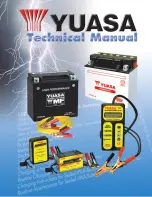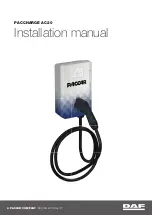
The requisite charging current for a battery is calculated according to the following formula:
Capacity in mAh x C coefficient = charging current
Example:
1000 x 5 = 5000 mA
A 1000 mAh battery with a coefficient of 5C requires a charging current of approx. 5 A.
If you can’t determine the C coefficients of a battery pack, always take a coefficient of 1C and
calculate the charging current using that. This is always a safe charging current. However, bear
in mind that the charging times can vary according to the actual (but not verified) battery data.
c) Characteristics of suitable battery types
LiPo Li-ion
LiFe
LiHV
NiCd
NiMH
Pb
Rated voltage
(V/cell)
3.7 V 3.6 V
3.3 V 3.8 V
1.2 V
1.2 V
2.0 V
Max. charging
voltage (V/cell)
4.2 V 4.1 V
3.6 V
4.35
V
1.5 V
1.5 V
2.46 V
Voltage for
storage (V/cell)
3.8 V 3.7 V
3.3 V 3.9 V
Not
supported
Not
supported
Not
supported
Charging current
for fast charging
≤1C
≤1C
≤4C
≤1C
1C-2C
1C-2C
≤0.4C
Min. voltage after
discharge (V/cell)
3.0 -
3.3 V
per
cell
2.9 -
3.2 V
per
cell
2.6 -
2.9 V
per
cell
3.1 -
3.4 V
per
cell
max. 0.1 -
1.1 V per
cell
max. 0.1 -
1.1 V per
cell
1.8 V per
cell
The voltages in the table above apply to a single cell. The maximum charging and
discharging currents are marked with the letter ‘C’ (capacity). A charging current of
1C corresponds to the capacity value printed on the battery (e.g. if the stated battery
capacity is 1000 mAh, the max. charging current is 1000 mA = 1 A).
When working with multi-cell battery packs, always ensure that the voltage setting
is correct. For example, with a two-cell battery pack, the individual cells can be con-
nected in parallel or in series.
Exceeding the maximum permitted charging current or selecting the wrong cell num-
ber/voltage setting may destroy the battery. In addition, the battery also poses a risk
of explosion and fire.
For further information on the maximum charging current and the number of cells/
voltage, refer to the data sheets or the battery label. These data take precedence
over the information in the table above.
Important!
Never charge battery packs with different types of cell (e.g. cells from different
manufacturers).
• Never charge non-rechargeable batteries.
• Never charge batteries that are not listed in the table above.
• Never charge batteries with integrated electronic components.
• Never charge batteries that are connected to other devices (e.g. a speed controller).
• Never charge damaged or deformed batteries.
Product overview
a) Charger
1
2
3
4
5
11
12
10
9
8
7
6
1 USB connection (charging connection) 2 Temperature sensor connection (for external)
3 Battery connection
+
4 Battery connection
-
5 Balancer connection
6
ENTER START
button
7
STATUS
INC +
button
8
STATUS DEC -
button
9
STOP BATT/PROG
button
10 LC display
11
AC INPUT 100 - 240 V
AC voltage
connection
12 Fan (controlled by temperature sensor)
Operation
a) Setup
•
Set the charger and battery on a non-flammable, heat-resistant surface (e.g. stone tiles)
close to a standard mains socket. Keep the charger and battery away from flammable
objects. Maintain a sufficient distance between the charger and the battery. Never place the
battery on top of the charger.
• Ensure that the ventilation openings on the base and sides of the charger are unobstructed
and that the fan is operating.
•
Keep the charger away from flammable or easily inflammable materials (e.g. curtains).
Never operate the charger on car seats, carpets or other flammable materials.
b) Connecting the charger to the power supply
Never operate the charger with an alternating voltage that is outside the range
specified in the technical data.
Operation via mains voltage
• The charger is operated via a mains voltage of 100 - 240 V/AC, 50/60 Hz.
• Connect the mains cable to the
AC 100 - 240 V
AC voltage connection
(11)
and plug the
mains plug into a standard mains socket.
Warning!
Always connect the charger to the power supply before connecting a bat-
tery.
• The charger switches on automatically when it is connected to the power supply. The display
lights up and displays a startup message. The charger beeps briefly.
• Afterwards, the charger is ready for use.
c) Charging USB devices
The charger has a USB charging connection. It can be used to charge the internal batteries of
compatible USB devices at 5 V/DC with up to 2.1 A.
The USB connection (charging connection)
(1)
cannot be used to update the firm
-
ware of the charger. It is only intended for charging suitable USB devices.
Please proceed as follows to charge a USB device:
• Connect a USB device to the USB connection
(1)
(charging connection) on the charger
using a suitable USB cable (not included) for charging.
• To do this, plug a USB A cable (not included with this product) into the USB connection.
• Connect the other end of the cable to device to be charged.
• Disconnect the connected device to interrupt the charging process or when charging is
complete.
• Always switch the connected device off before disconnecting it from the charger.
You can charge USB devices at up to 10.5 W power at this output. It supports the
charging of different USB devices e.g. smartphones, headsets, digital cameras, etc.







































